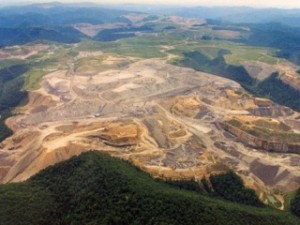ACE Report: Cleaning Up Coal
Open Google Doc of Cleaning Up Coal
By Rebecca Anderson, ACE Director of Education

But that pollution is only the beginning. For those of us who don’t work in a coal mine or live downstream from one, the pollution we get from coal comes when we burn it.
Americans love to burn coal. The U.S. has the world’s largest supply of recoverable coal, over 275 billion tons. That’s more energy than all the rest of the world’s oil reserves. That’s a LOT of coal.
We burn over one billion tons of that coal every year. That means that, on average, each person in the U.S. uses about 3.8 tons of coal each year. And 9 out of every 10 tons goes to making electricity. Just over half of the electricity in the U.S. comes from burning coal. (You can find out where your electricity comes from on the EPA’s website.) (Note: The amount of coal burned to produce electricity has gone down in recent years to about 38%.)
After the coal gets mined (mostly in the West these days – see map), it gets transported via train, barge or truck (60% goes by train) to a power plant. There are 491 coal-fired power plants around the U.S. today. You can find out if there’s one near you on the Sierra Club’s website.
When coal gets burned to create electricity, it produces CO2. CO2 from power plants accounts for 30% of all U.S. CO2 emissions and coal-fired power plants account for about 80% of that.
But here’s what goes along with theCO2:
- Sulfur dioxide (SO2). This causes acid rain and also contributes to respiratory disease.
- Nitrogen oxides (NOx), which creates smog (ozone) that also contributes to respiratory disease and aggravates asthma.
- Tiny airborne particles (PM2.5 or particulate matter smaller than 2.5 microns) that cause bronchitis, respiratory and heart disease and premature death.
- Arsenic, a known carcinogen.
- Mercury. Less than a teaspoon of mercury can contaminate an entire lake. Mercury accumulates in the environment in streams and lakes, often ending up in fish and affecting people who eat fish. Mercury is particularly harmful for child brain development.
- Lead
We know this stuff is bad. Much of it is already regulated under the Clean Air Act. But the Clean Air Act doesn’t cover all power plants. Many coal-fired power plants have installed “scrubbers” on their smokestacks that reduce much of this pollution by up to 95%, either voluntarily or through state laws.
Right now the EPA is working on two new regulations to get at this pollution. One, MATS (Mercury and Air Toxics Standards) would limit the amount of mercury and other toxins like lead and arsenic that come from power plants. Right now there is no national limit on these pollutants like mercury from power plants. Hard to believe, but true. The EPA estimates this regulation could prevent up to 17,000 premature deaths a year.
The other EPA regulation is the Cross-State Air Pollution Rule, which requires 27 states to reduce pollution from power plants that crosses state lines, specifically the SO2 and NOx that contribute to fine particle (aka PM2.5) and ozone pollution. The EPA also estimates this rule would avoid thousands of premature deaths, heart attacks, hospital visits and hundreds of thousands of asthma attacks, in addition to saving billions of dollars in health care costs.
The American Coal Foundation’s website says that if we continue to burn coal at today’s rates, American has enough coal supplies to last another 300 years. On one hand, that’s energy security. But on the other, that’s millions of lives damaged by the myriad of health impacts that come from mining and burning coal. I truly hope that 300 years from now, we won’t have finally moved on to another energy source besides coal only because we burned it all up.
Cleaning Up Coal
Student Worksheet
Name:
1. What are 3 ways that coal pollutes?
2. What country has the world’s largest supply of coal?
3. When this report was written in 2011, roughly what percentage of the U.S.’s electricity came from burning coal?
4. As of today, what percentage of U.S. electricity comes from burning coal? What has caused the change? (You’re gonna have to research this!)
5. Using the link to the EPA’s Power Profiler, where does your electricity come from?
6. How far away is the closest coal-fired power plant from you?
7. What are 5 other pollutants that coal-fired plants produce in addition to CO2? What’s one health impact of each of them?
8. What are the two new proposed EPA regulations aimed to reduce this pollution?
9. BONUS: What is the current state of each of these regulations? (Go to the EPA’s website to find out.)
